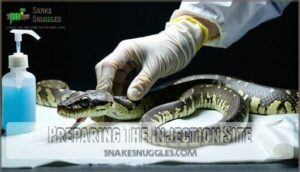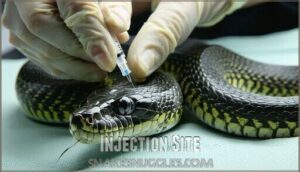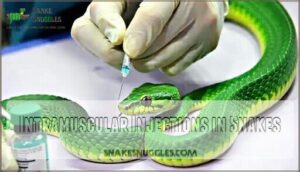This site is supported by our readers. We may earn a commission, at no cost to you, if you purchase through links.
 Learning how to inject a snake safely requires proper veterinary training and expertise.
Learning how to inject a snake safely requires proper veterinary training and expertise.
You’ll need to secure your snake gently but firmly, typically behind the head and mid-body.
Choose injection sites carefully – the lateral body wall works best for subcutaneous injections, while specific muscle groups suit intramuscular delivery.
Snake skin’s tougher than you’d expect, so insert the needle confidently at a 45-degree angle.
Never attempt injections near the spine, heart, or lungs.
Think of it like threading a needle while your "thread" has scales and attitude.
Most snake medications require precise dosing and sterile technique.
Professional guidance makes all the difference between success and disaster, emphasizing the need for proper veterinary training.
Table Of Contents
- Key Takeaways
- How to Inject a Snake?
- Restraint and Preparation for Injecting Snakes
- Subcutaneous Injections in Snakes
- Intramuscular Injections in Snakes
- Considerations for Injecting Snakes
- Types of Injections in Snakes
- Frequently Asked Questions (FAQs)
- Where do you give a snake an injection?
- What is the best site for an IM injection in a snake?
- Which is the most common site used for IM injections in snakes?
- How to give medication to a snake?
- Where to inject snake antibiotics?
- How to give a snake subcutaneous fluids?
- Can you give a snake an IV?
- Where should an IM injection be given to a chelonian?
- How do you inject a snake?
- What are the different types of snake injections?
- Conclusion
Key Takeaways
- You’ll need proper veterinary training before attempting any snake injection – never try this without professional guidance, as improper technique can harm both you and your snake.
- Target the right injection sites carefully – aim for muscles beside the spine in the front half of the body for intramuscular injections, or skin lateral to the ribs for subcutaneous injections, always avoiding the spine, heart, and kidney areas.
- Secure your snake properly before injecting – restrain the head and mid-body firmly, use the right needle size, and insert at a 45-degree angle between scales with confident, steady movements.
- Choose between subcutaneous and intramuscular methods based on your medication needs – subcutaneous injections work well for most medications and are gentler, while intramuscular injections provide better absorption for antibiotics and pain control.
How to Inject a Snake?
Injecting a snake requires understanding snake anatomy and choosing the right injection site for subcutaneous injection or intramuscular injection.
Snake injections demand precision—know your anatomy, pick your spot, and keep your patient (and yourself) safe.
You’ll need proper needle size, accurate dosage calculation, and attention to hydration importance.
Snake injection demands veterinary guidance to prevent injection complications and guarantee safe disposal of materials afterward.
Restraint and Preparation for Injecting Snakes
You’ll need to secure your snake properly before administering any injection, which can feel like trying to hold a garden hose that’s decided it has other plans.
Start by gathering your supplies and choosing the right restraint method based on your snake’s size and temperament, because a well-prepared injection goes much smoother than a wrestling match.
Proper Restraint
You’ll need solid snake restraint before attempting any injection.
Secure the head and body firmly—never grab the tail, as this causes injury.
For aggressive snakes, consider sedation options or restraint tools like tubes and hooks.
Understanding defensive snake signals can help prevent bites.
Having an assistant handle the snake’s head while you focus on the injection site guarantees safe handling while minimizing stress for both you and your patient.
Preparing The Injection Site
Once you’ve secured your snake, locate the injection site by feeling for the hard spine along the snake’s back. The softer muscle tissue sits on either side.
Part the scales gently to expose clean skin, then disinfect the area thoroughly. Proper technique may require snake injection supplies to ensure a safe and effective process.
Clean your workspace and prepare your dosage. Position the needle at a 45-degree angle between scales, aiming for muscle tissue in the snake’s front half.
Subcutaneous Injections in Snakes
Subcutaneous injections are your go-to method for most snake medications, placing the needle just under the skin rather than deep into muscle tissue.
You’ll find this technique gentler on your scaly patient and easier to master than other injection methods, though proper restraint and site selection remain essential for everyone’s safety.
Injection Site
Finding the right injection site for subcutaneous snake injections isn’t rocket science, but precision matters.
You’ll target the skin lateral to the ribs, avoiding the spine and kidney areas completely.
Key considerations for ideal scale placement:
- Choose loose scales that separate easily without forcing
- Select the front half of the body for better access and comfort
- Avoid bony areas like the spine to prevent tissue damage.
For specialized supplies, consider browsing snake subcutaneous needles.
Proper injection site selection protects your snake’s anatomy while ensuring effective medication delivery through correct injection technique.
Technique
Getting the needle angle right makes all the difference in subcutaneous snake injections. Hold your needle at a 45-degree angle and slip it smoothly between the scales into the skin lateral to the ribs. Your hand placement should secure the snake while maintaining sterile technique throughout the process.
Control your injection speed to guarantee dosage accuracy—too fast can cause tissue damage or medication leakage. Many veterinarians source their specialized reptile supplies online.
Follow these snake injection techniques for success:
- Verify proper restraint before starting the injection site preparation
- Insert the needle steadily using correct needle angle positioning
- Administer medication slowly for ideal absorption and comfort
- Monitor post-injection for adverse reactions or complications
Intramuscular Injections in Snakes
When administering intramuscular injections in snakes, precision beats speed every time.
You’ll target the epaxial muscles flanking the spine in the cranial half of your snake’s body—these soft muscle groups provide ideal absorption for medications like antibiotics and pain control.
Here’s your step-by-step approach:
- Muscle Selection and Injection Site: Locate the hard spine, then aim for the softer tissue on either side. Choose larger muscle areas toward the head for better drug distribution.
- Injection Angle and Needle Size: Insert your needle at a 45-degree angle between scales, advancing into the muscle’s center. Use appropriate needle gauge for your snake’s size.
- Dosage Calculation and Administration: Verify your medication dosage, eliminate air bubbles, then inject slowly to prevent tissue damage.
Post-injection monitoring is vital—watch for adverse reactions while your snake recovers. Be aware that respiratory disease symptoms can sometimes be triggered by stress post-injection. This intramuscular injection technique guarantees reliable drug uptake and consistent results for your reptile patient’s health.
Considerations for Injecting Snakes
When you’re ready to inject your snake, remember that not all body areas are created equal—some spots can cause serious harm if you hit them.
You’ll want to steer clear of the kidney region and caudal body areas, and it’s always smart to have your vet show you the ropes before you go solo with that syringe.
Avoid Certain Areas
While mastering intramuscular techniques, you’ll need to avoid certain danger zones during snake injection.
Never inject into the kidney area or caudal body, as medications get eliminated before working effectively. Skip areas with space lesions, and verify proper hydration levels first.
Consider species anatomy when selecting injection sites—what works for one snake won’t work for another. Injectable medications are often preferred because of the reptile’s eating habits.
- Kidney area injections can waste expensive medications completely
- Caudal body shots often fail when your snake needs treatment most
- Poor injection site selection risks your snake’s recovery and your confidence
Consult a Veterinarian
Beyond avoiding problematic areas, you’ll want Professional Guidance from a snake vet before attempting any reptile medication administration.
Veterinarian consultation guarantees proper technique and prevents Injection Complications that could harm your pet. Ensuring proper snake temperature control is also vital for their recovery.
Your reptile expert will teach you these critical aspects:
- Needle selection – Choose the right gauge for your snake’s size
- Dosage Accuracy – Calculate precise amounts based on Species Specifics
- Medication Choice – Select appropriate drugs for the condition
- Timing protocols – Schedule injections for maximal effectiveness
Types of Injections in Snakes
When you’re ready to administer medication to your snake, you’ll need to choose between three main injection types: subcutaneous (under the skin), intramuscular (into the muscle), and intracoelomic (into the body cavity).
Each method serves different purposes and requires specific techniques, so understanding which one your vet recommends can make the difference between a smooth procedure and a wrestling match with a very uncooperative patient, involving a potentially uncooperative patient.
This understanding is crucial for the smooth procedure of medication administration.
Subcutaneous Injections
Subcutaneous injections deliver medication just under your snake’s skin for maximum absorption rate.
Think of it like giving a tiny shot to a scaly patient who definitely didn’t sign up for this appointment.
Think of it like giving a tiny shot to a scaly patient who can’t sit still.
Wrestling with a garden hose that’s decided it has better places to be than in your hands.
- Target the lateral rib area – avoid the spine and use proper needle gauge
- Maintain adequate snake hydration before injection volume administration
- Watch for post-injection swelling at the reptile medication site
Intramuscular Injections
When targeting muscle tissue for intramuscular injection, you’ll focus on the softer areas flanking your snake’s spine in the cranial half of the body.
Ensuring proper snake health is essential for successful treatment outcomes.
- Injection angle: Position needle at 45 degrees between scales
- Muscle selection: Target areas beside spine, avoiding the hard backbone
- Needle size: Use small gauge for minimal tissue damage
- Dosage calculation: Administer prescribed volume slowly into muscle
- Post-injection monitoring: Watch for adverse reactions after administration
Intracoelomic Injections
Intracoelomic injections deliver medication directly into your snake’s abdominal cavity, though they’re less common due to anatomical constraints.
You’ll inject in the caudal third, avoiding essential organs and ensuring proper hydration status beforehand.
Like other injection types, ensuring accurate reptile weighing is critical to avoid overdosing.
Key considerations include:
- Volume limits – Only small amounts due to lack of extensible cavities
- Lesion avoidance – Skip this route if space-occupying masses exist
- Monitoring needed – Watch for respiratory compromise post-injection
Frequently Asked Questions (FAQs)
Where do you give a snake an injection?
You’ll inject snakes in two main spots: subcutaneously in the skin lateral to the ribs, or intramuscularly in muscles beside the spine.
Choose the front half of the body for both injection types.
What is the best site for an IM injection in a snake?
Picture yourself gently parting your snake’s scales like opening a book.
You’ll target the muscles beside the spine in the front half of the body, inserting the needle at a 45-degree angle between scales.
Which is the most common site used for IM injections in snakes?
The muscles beside the spine in the cranial half offer the most reliable target.
You’ll find softer tissue on either side of the hard backbone, providing adequate muscle mass for proper medication absorption.
How to give medication to a snake?
About 100,000 people die from snake venom annually, making proper medical care essential. You’ll give medications through intramuscular injections in muscles beside the spine or subcutaneous injections under the skin.
Where to inject snake antibiotics?
Target the muscles beside your snake’s spine in the front half of its body.
Insert the needle at a 45-degree angle between scales, avoiding the hard backbone and staying away from the kidney area.
How to give a snake subcutaneous fluids?
Like threading a needle through silk, you’ll deliver subcutaneous fluids by inserting the needle at a 45-degree angle between your snake’s scales.
Targeting the skin lateral to the ribs in the front half is crucial for the procedure.
Can you give a snake an IV?
Yes, you can give a snake an IV injection, but it’s typically performed by veterinarians in clinical settings.
The ventral tail vein is the usual site, requiring precise technique and proper restraint for safety.
Where should an IM injection be given to a chelonian?
Looking at chelonian anatomy reveals a key principle: muscle mass determines injection success.
You’ll want to target the triceps muscle in the front limbs or the large muscle groups in the rear limbs for ideal intramuscular delivery.
How do you inject a snake?
Restrain your snake securely, then locate muscles beside the spine in the front half. Insert the needle at 45 degrees between scales into muscle tissue. Administer slowly and monitor afterward.
What are the different types of snake injections?
Approximately 100,000 people die from snake bites annually worldwide. You’ll encounter three main injection types: subcutaneous (under skin), intramuscular (into muscle), and intravenous (into vein). Each serves different medical purposes effectively.
Conclusion
Ready to master how to inject a snake safely?
Remember that proper restraint, sterile technique, and precise injection sites make all the difference in successful reptile care.
You’ll want to avoid sensitive areas like the spine and heart while maintaining confidence with your needle placement.
Most importantly, don’t attempt snake injections without proper veterinary training or professional guidance.
When you’re dealing with scaled patients, expertise isn’t optional—it’s essential for both safety and success.













